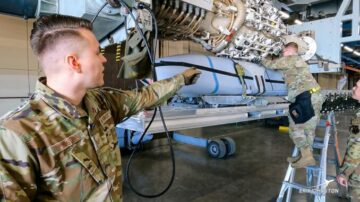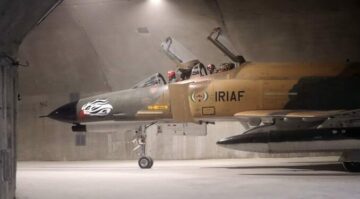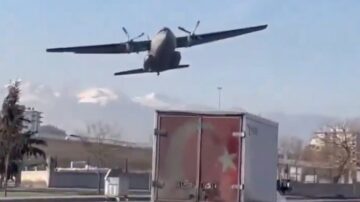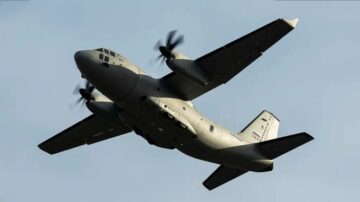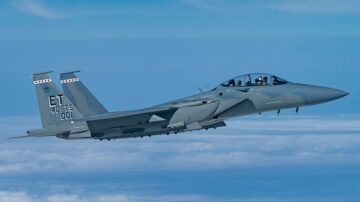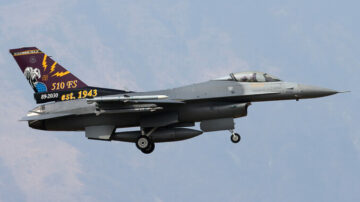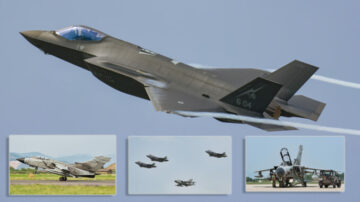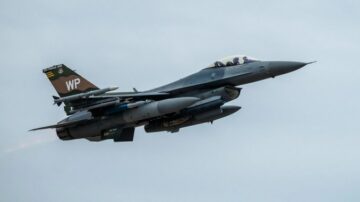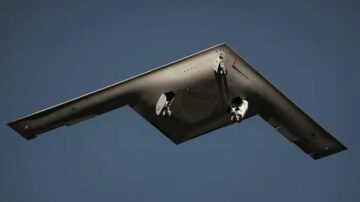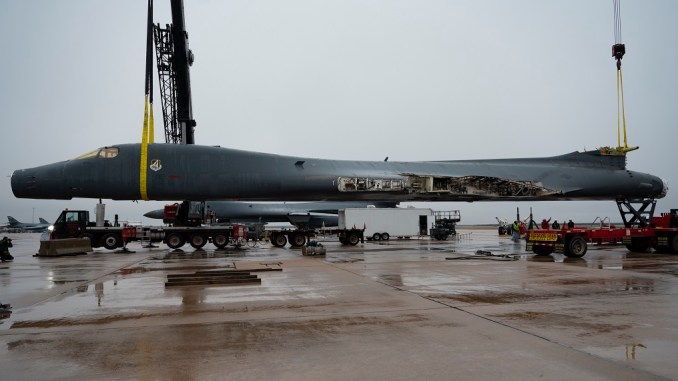
The aircraft, stored at AMARG’s “Boneyard” for years, will return to Dyess AFB later this year.
On April 20, 2022, a B-1B Lancer bomber of the 7th Bomb Wing, serial 85-0089, experienced a catastrophic engine failure and fire on the #1 engine while undergoing maintenance on the main ramp at Dyess AFB, Texas. On February 8, 2024, work started on a BONE (as the B-1s are nicknamed within the pilot community) that will replace the damaged one later this year.
The aircraft might be one of the 17 B-1Bs that were retired in 2021, as Air Force Global Strike Command noted at the time that four of them would be maintained “in a reclaimable condition”. Since then, the bomber has been stored in the 309th Aerospace Maintenance and Regeneration Group’s “Boneyard” at Davis-Monthan Air Force Base.
This B-1B recently left the “Boneyard” and landed at Tinker AFB for heavy restoration and maintenance. After numerous inspections and upgrades, the aircraft will join the Dyess fleet later this year, marking the first time in 20 years that a BONE will be put back in service after being retired. The last time was when the Air Force retired 33 B-1s in 2003 and returned seven of them to service the next year.
“The fact that our Air Force can call up an aircraft that has sat dormant for several years and prepare it to support our long-range strike mission, all within a year, is incredible,” said Col. Seth Spanier, 7th Bomb Wing commander. “This entire effort speaks to our unwavering commitment to maintaining a combat-credible strike force.”
The catastrophic engine failure
Mechanics with the 7th Aircraft Maintenance Squadron at Dyess AFB were working on aircraft 85-0089 to perform routine corrective maintenance on the #1 engine variable area exhaust nozzle. During the engine’s run-up to maximum augmenter to verify the correct functioning of the system, the engine catastrophically failed.
The Oklahoma City Air Logistics Complex at Tinker Air Force Base, Oklahoma, is the largest depot repair complex in the Air Force. The Complex’s depot Artisans perform award-winning program depot maintenance and modifications on B-1 Lancer aircraft, supporting the sustainment of combat-ready airpower. (U.S. Air Force photo/Gina Anderson)
” data-medium-file=”https://i0.wp.com/theaviationist.com/wp-content/uploads/2024/04/B-1B_Regenerated_From_Boneyard_2.jpeg?fit=460%2C307&ssl=1″ data-large-file=”https://i0.wp.com/theaviationist.com/wp-content/uploads/2024/04/B-1B_Regenerated_From_Boneyard_2.jpeg?fit=706%2C471&ssl=1″ decoding=”async” class=”size-large wp-image-85341″ src=”https://platoaistream.net/wp-content/uploads/2024/04/stored-b-1b-regenerated-to-replace-damaged-bomber-1.jpg” alt width=”706″ height=”471″ srcset=”https://platoaistream.net/wp-content/uploads/2024/04/stored-b-1b-regenerated-to-replace-damaged-bomber-1.jpg 706w, https://platoaistream.net/wp-content/uploads/2024/04/stored-b-1b-regenerated-to-replace-damaged-bomber-2.jpg 460w, https://platoaistream.net/wp-content/uploads/2024/04/stored-b-1b-regenerated-to-replace-damaged-bomber-3.jpg 128w, https://platoaistream.net/wp-content/uploads/2024/04/stored-b-1b-regenerated-to-replace-damaged-bomber-4.jpg 768w, https://i0.wp.com/theaviationist.com/wp-content/uploads/2024/04/B-1B_Regenerated_From_Boneyard_2.jpeg?w=1024&ssl=1 1024w” sizes=”(max-width: 706px) 100vw, 706px” data-recalc-dims=”1″>
The investigation found out that the incident was caused by high cycle fatigue which initiated a crack on the surface of the 2nd stage fan disk, which then propagated and then ultimately caused the disk to break apart. The failure caused the disk to be ejected from the intake section, severing the fuel lines and causing a fire. The fan disk landed over 500 ft from the aircraft, while debris struck one Airmen who suffered minor injuries.
Starting in October 2023, Dyess and Tinker AFB maintenance teams began to demilitarize the damaged B-1B and, following an aircraft wash, maintenance personnel prepared the aircraft to salvage 49 parts valued at over $2.7 million. Damage caused by the mishap was worth about $15 million, according to the investigation report.
Salvageable parts were transported to squadrons at Dyess AFB for training purposes. The left wing and left nacelle were transported to the 436th Training Squadron crash lab, the only crash lab in Air Combat Command, to support their aircraft mishap investigation course. The fuselage was recently transported to the National Institute for Aviation Research at Wichita State University, Kansas, to facilitate the forward intermediate fuselage super panel prototype, mentioned the Air Force.
“This is an example of our team thriving despite some initial adversity,” said Col. Joshua Pope, 7th Maintenance Group commander. “The demilitarization project facilitated proactive inspections and the repair of structural components by personnel, reducing repair costs, timelines, and the impact on aircraft availability, all while upholding fleet safety.”
- SEO Powered Content & PR Distribution. Get Amplified Today.
- PlatoData.Network Vertical Generative Ai. Empower Yourself. Access Here.
- PlatoAiStream. Web3 Intelligence. Knowledge Amplified. Access Here.
- PlatoESG. Carbon, CleanTech, Energy, Environment, Solar, Waste Management. Access Here.
- PlatoHealth. Biotech and Clinical Trials Intelligence. Access Here.
- Source: https://theaviationist.com/2024/04/04/stored-b-1b-regenerated-to-replace-damaged-bomber/?utm_source=rss&utm_medium=rss&utm_campaign=stored-b-1b-regenerated-to-replace-damaged-bomber
- :has
- :is
- $UP
- 1
- 125
- 17
- 1st
- 20
- 20 years
- 2021
- 2022
- 2023
- 2024
- 23
- 2nd
- 33
- 49
- 500
- 7
- 7th
- 8
- a
- About
- According
- Achieve
- Aerospace
- aerospace engineering
- After
- AIR
- Air Force
- aircraft
- All
- also
- among
- an
- and
- anderson
- apart
- applied
- April
- ARE
- AREA
- areas
- artisans
- AS
- At
- availability
- avatar
- aviation
- award-winning
- back
- base
- based
- BE
- been
- began
- being
- bomb
- BONE
- Break
- by
- call
- CAN
- catastrophic
- catastrophically failed
- caused
- causing
- City
- class
- combat
- command
- commitment
- community
- complex
- components
- conflicts
- contributor
- correct
- Costs
- course
- crack
- Crash
- Current
- cycle
- damage
- Degree
- Despite
- during
- effort
- Electronic
- Engine
- Engineering
- Entire
- Ether (ETH)
- example
- expertise
- facilitate
- facilitated
- fact
- Failed
- Failure
- fan
- fatigue
- February
- Fire
- First
- first time
- FLEET
- following
- For
- Force
- Forward
- found
- four
- freelance
- from
- FT
- Fuel
- functioning
- Global
- graduate
- Group
- Group’s
- he
- heavy
- High
- his
- HTTPS
- Impact
- in
- incident
- incredible
- initial
- initiated
- Institute
- Intermediate
- investigation
- IT
- Italy
- Jan
- join
- joshua
- journalist
- jpeg
- Kansas
- lab
- largest
- Last
- later
- left
- lines
- logistics
- Main
- maintained
- maintaining
- maintenance
- marking
- master
- max-width
- maximum
- mentioned
- might
- Military
- million
- minor
- Mission
- Modifications
- National
- next
- noted
- numerous
- october
- of
- Oklahoma
- on
- ONE
- only
- Operations
- osint
- our
- out
- over
- panel
- parts
- perform
- Personnel
- photo
- pilot
- plato
- Plato Data Intelligence
- PlatoData
- pope
- Prepare
- prepared
- Prepares
- Proactive
- Program
- project
- prototype
- purposes
- put
- Ramp
- recently
- reducing
- regeneration
- repair
- replace
- research
- restoration
- return
- routine
- s
- Safety
- Said
- Section
- serial
- service
- seven
- several
- since
- some
- Speaks
- Stage
- started
- State
- stored
- strike
- structural
- Studying
- suffered
- Super
- support
- Supporting
- Surface
- system
- team
- teams
- techniques
- texas
- that
- The
- the world
- their
- Them
- then
- this
- this year
- thriving
- time
- timelines
- to
- Training
- transported
- u.s.
- U.S. Air Force
- Ultimately
- undergoing
- university
- unwavering
- upgrades
- upholding
- valued
- verify
- was
- were
- when
- which
- while
- WHO
- will
- Wing
- with
- within
- Work
- working
- world
- worth
- would
- year
- years
- zephyrnet


